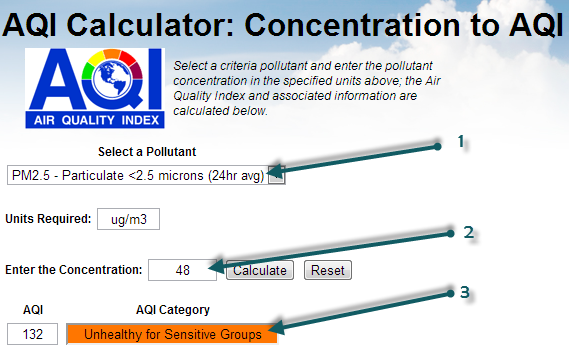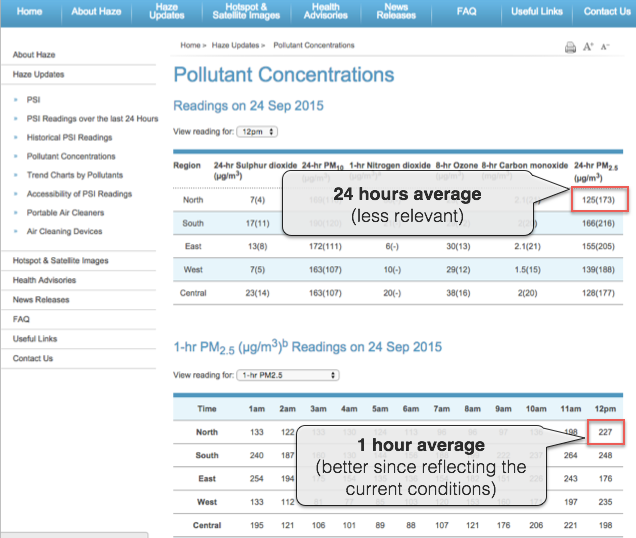In April 2014, the Singapore NEA has updated the PSI calculation to also include PM2.5. http://www.nea.gov.sg/anti-pollution-radiation-protection/air-pollution-control/psi
With the recent Southeast Asia Smog from Indonesia affecting Singapore and now Malaysia, we got many questions about why there is a difference between the data which can be read from Singapore NEA website (nea.gov.sg) and the World Air Quality Index project Singapore webpage.
उदाहरण के लिए, एनईए वेबसाइट पर आज क्या पढ़ा जा सकता है:

कुछ ऐतिहासिक कारणों से, सिंगापुर वायु गुणवत्ता का मूल्यांकन करने के लिए पीएसआई ( प्रदूषक मानक सूचकांक ) का उपयोग कर रहा है। ऊपर की छवि में, नंबर 1 पीएम10 मान से मेल खाता है जिसका उपयोग पीएसआई मूल्यांकन के लिए किया जाता है। मान 67(/59) 67 μg/m3 के रूप में पढ़ा जा सकता है, जो 59 के पीएसआई के अनुरूप है। पीएसआई का मूल्यांकन प्रत्येक प्रदूषक के लिए व्यक्तिगत पीएसआई की अधिकतम के रूप में किया जाता है: पीएम 10 , एसओ 2 , एनओ 2 , ओ 3 (ओजोन) और सीओ 2 ।
PSI(Singapore-North) = max( PSIPM10-based, ... PSIO3-based )= max (59, ..., 77) = 77
इसने कहा, दिलचस्प बात यह है कि, इसी तालिका में, अंतिम कॉलम में PM2.5 डेटा भी प्रदान किया गया है (देखें 3)। यह डेटा केवल μg/m3 में प्रदान किया गया है (देखें 2), और PSI जैसी किसी चीज़ में कोई रूपांतरण नहीं है (यानी PM2.5 द्रव्यमान से प्रदूषण या गुणवत्ता सूचकांक में रूपांतरण)। हालाँकि यह रूपांतरण मौजूद है, और इसे अमेरिकी पर्यावरण संरक्षण एजेंसी द्वारा परिभाषित किया गया है। रूपांतरण करने का सबसे आसान तरीका ऑनलाइन कैलकुलेटर का उपयोग करना है, जो airnow.gov पर उपलब्ध है:

If you select the PM2.5 (1), then enter the mass concentration of 48 (2), can click on Calculate, you will obtain the AQI of 132 (3). So, based on the PM2.5 AQI conversion, the PSI that is used for Singapore could be extended (let's call it PSI++) to also take into account the PM2.5 information. In which case, the PSI++ would be the maximum of the regular PSI (based on PM10 only) and the PM2.5 AQI:
PSI++ = max( PSI, AQIPM.25 ) = max( 77, 132 ) = 132
This PSI++, that is commonly referred as AQI (or Air Quality Index), is what is being used on the the World Air Quality Index project, for all the cities (provided PM2.5 is available for the city). And this explains why the values are different between the NEA website and the World Air Quality Index project.
Moreover, when doing the convertion, make sure you use the 1-hour reading for the PM2.5 concentration rather than the 24-hours averaged value, as shown on the below image:

http://www.haze.gov.sg/haze-updates/pollutant-concentrations/type/PM25-1Hr
If you want to know more about PM10 vs PM2.5, and especially why PM10 is still used, please check the faq entry about why is PM2.5 often higher than PM10? Is PM10 still a relevant measure?
--
For more information about specific countries or continent, please refer to those articles: Thailand and Malysia - India - China - Hong Kong / Canada (Air Quality Health Index) - South America - Australia - Quebec and Montreal - Singapore - Poland - Indonesia .
For information about the 24 hours averaging used or Ozone and Particulate Matter (PM2.5), please refer to those two articles: Ground Ozone Index - PM2.5 Instant Cast
